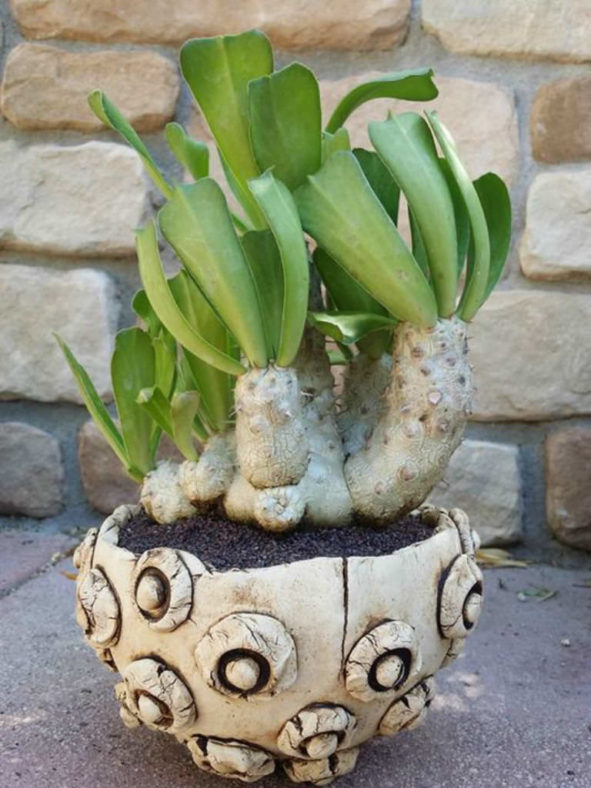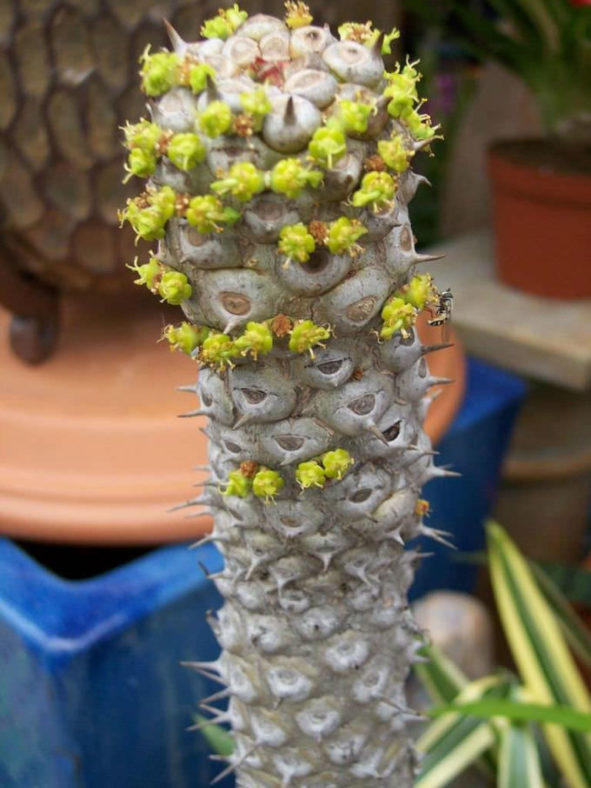Scientific Name
Euphorbia unispina N.E.Br.
Common Name(s)
Candle Plant
Scientific Classification
Family: Euphorbiaceae
Subfamily: Euphorbioideae
Tribe: Euphorbieae
Subtribe: Euphorbiinae
Genus: Euphorbia
Etymology
The specific epithet "unispina" (pronounced "un-ee-SPIN-a") means "one-spined." It refers to the single spine per spine shield in this species, unlike many Euphorbia species, which typically have two spines per spine shield.
Origin
Euphorbia unispina occurs from Guinea and Mali east to southern Sudan. It grows on rocky hills in the savannah.
Description
Euphorbia unispina is a shrubby or tree-like succulent with a thick stem, usually with 3 to 4 cylindrical branches and wedge-shaped leaves arranged in a terminal rosette. It can grow up to 10 feet (3 m) tall. The branches are silvery-grey, with obscure tubercles arranged in spiral lines and spine shields with a single spine. The leaves are green, often with reddish margins. They can measure up to 4.8 inches (12 cm) in length and 1 inch (2.5 cm) in width. The spine shields can reach a diameter of 0.4 inches (1 cm). The spines are dark grey, cone-shaped, and can grow up to 0.5 inches (1.2 cm) long. The older specimens can be spineless.
The flowers (cyathia) are yellow-green, 5-lobed, and appear at the end of the dry season before the new leaves appear. They can measure up to 0.2 inches (0.5 cm) in diameter. Usually, the cymes are composed of three cyathia, one terminal and two lateral.

How to Grow and Care for Euphorbia unispina
Hardiness: USDA hardiness zones 9b to 11b: from 25°F (-3.9°C) to 50°F (10°C).
Euphorbias are very easy to care for. These plants require a little pampering to become established, but once they are, they are self-sufficient. More die from overcare and overwatering than from neglect. Euphorbias need well-draining soil and lots of sunlight. They are not particular about soil pH, but cannot tolerate wet soil. Unlike most succulents, Euphorbia does not tolerate long periods of drought. It may need weekly watering during the summer. Water whenever the soil is dry several inches below the surface. Water deeply, but don't let them sit in wet soil, which can cause root rot. Add some organic matter or fertilizer to the planting hole. If you are growing them in containers or your soil is poor, feed them with a half-strength fertilizer monthly.
These succulents can be grown from seed, but germination can be tricky (or even hard to find). They are usually propagated by cuttings. This can be tricky because of the exuding sap. Rooting hormone is recommended with Euphorbia. They tend to grow problem-free, but there are a few pests and diseases to be alert for.
Learn more at How to Grow and Care for Euphorbia.
Links
- Back to genus Euphorbia
- Succupedia: Browse succulents by Scientific Name, Common Name, Genus, Family, USDA Hardiness Zone, Origin, or cacti by Genus
Photo Gallery
Click on a photo to see a larger version.


